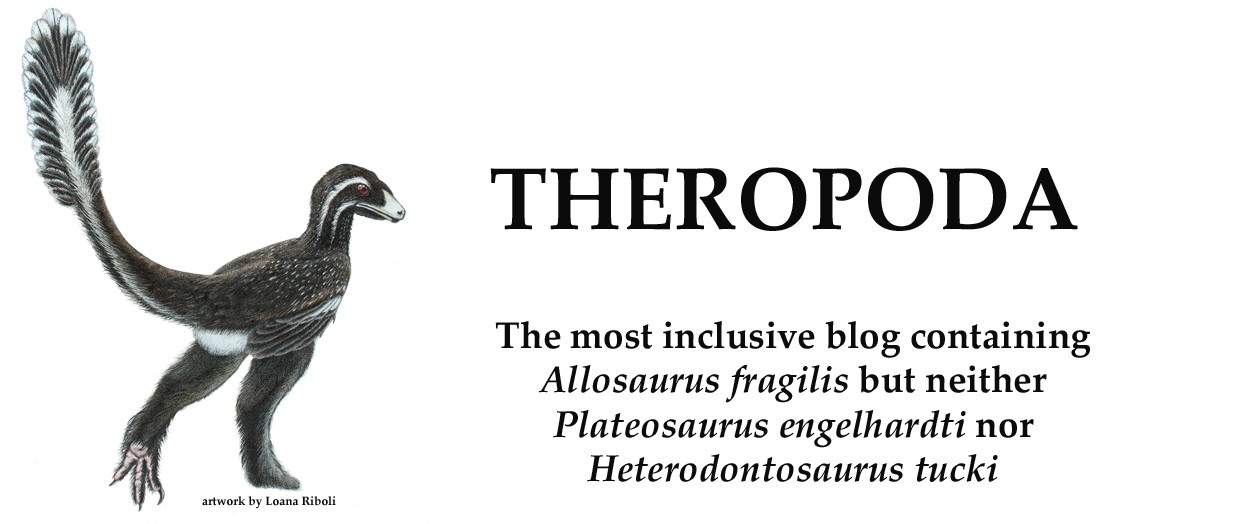| Olotipo di Tarascosaurus salluvicus in varie viste (da LeLoeuff e Buffetaut 1991) |
Il record fossile relativo a Ceratosauria è concentrato sopratutto nel Gondwana. Attualmente, tutti i ceratosauri laurasiatici del Cretacico sono europei, in particolare in Francia e nella regione balcanica orientale. Tra i primi ceratosauri cretacici europei è Tarascosaurus salluvicus (LeLoeuff e Buffetaut 1991), dal Cretacico Superiore francese.
L'olotipo di Tarascosaurus è un femore parziale, al quale è associata una coppia di vertebre dorsali parziali e (in modo dubbio) una caudale frammentaria (non descritta).
Il femore di Tarascosaurus presenta una combinazione di caratteri esclusiva degli abelisauroidi: la testa è rivolta anteromedialmente, ed il trocantere anteriore è allungato anteroposteriormente. Il risultato di questa combinazione è che il femore in vista prossimale è a "U" (figura 5 qui sopra). Questo ultimo carattere è stato considerato da alcuni autori sinapomorfico per gli abelisauroidi, tuttavia, come ho mostrato, esso non è un vero carattere, una struttura che evolve in modo relativamente autonomo ed indipendente dal resto del femore, bensì una combinazione di due caratteri, uno plesiomorfico (la direzione della testa) ed uno derivato (l'allungamento del trocantere). Se si scoprisse un eventuale femore di tetanuro molto basale, con la testa diretta anteromedialmente, è probabile che mostrerebbe una morfologia prossimale del femore simile a quella abelisauroide. Le vertebre dorsali, probabilmente anteriori data la posizione della parapofisi, mostrano una marcata pneumatizzazione dell'arco, un pleurocoelo anteriore nel centro, l'ossificazione dell'apice anteriore dei ligamenti interspinali (come in Dilophosaurus e i compsognathoidi), una robusta parapofisi peduncolata, diapofisi ampie e proiettate posterodorsalmente. Anche se nel 1991 poteva risultare diagnostico, il materiale di Tarascosaurus non mostra attualmente caratteri unici di questo taxon, che è quindi un probabile nomen dubium.
Assumendo che femore e vertebre appartengano allo stesso individuo (e non paiono esserci obiezioni a questa associazione, data la taglia comparabile, la provenienza comune e la condivisione di caratteri abelisauroidi), l'inclusione di Tarascosaurus in Megamatrice lo colloca in Noasauridae, più affine ai taxa africani (Elaphrosaurus e Bahariasaurus/Deltadromeus) che ai taxa più meridionali: ciò può avere qualche implicazione paleobiogeografica, di cui parlerò in futuro.
Ringrazio Alessandro Chiarenza per avermi inviato una copia di Le Loeuff e Buffetaut (1991).
Bibliografia:
Jean Le Loeuff and Eric Buffetaut (1991). Tarascosaurus salluvicus nov. gen., nov. sp.,dinosaure théropode du Crétacé supérieur du Sud de la France. Geobios, 24(5): 585-594.

Considering the noasaurid affinities of both Tarascosaurus and Genusaurus, would it be possible they both belong to the same taxon? Or am I forgetting an important temporal/spatial distinction?
RispondiEliminaMy analysis places Genusaurus in Abelisauridae. The two differ in femur morphology. The latter is Lower Cretaceous. I don't find their synonymy supported.
RispondiEliminaAh, ok, thank you for clearing that up.
RispondiEliminaBut if your analysis places it closest to Deltadromeus/Bahariasaurus and Elaphrosaurus, and the femur differs pretty clearly from both (e.g. more distally placed and cylindrical anterior trochanter is different from Deltadromeus, femoral head not strongly tilted anteriorly is different from Elaphrosaurus), how can Tarascosaurus be a nomen dubium? The diagnosis would just be whatever chaacters place it closer to those, plus whatever characters it differs from those in.
RispondiEliminaI suspect most of the reviewers of a paper suggesting such a diagnosis for Tarascosaurus would consider it as a nomen nudum arguing that it's based on plesiomorphies.
EliminaIt'd be a combination of plesiomorphies and apomorphies (those characters placing it with Deltadromeus and Elaphrosaurus, or inside Noasauridae).
RispondiEliminaI agree that a taxon can be diagnosed by the combination of plesio- and apomorphies that differentiates it from its closest relative. At the same time, Tarascosaurus is based on a very fragmentary specimen and I suspect its position is so unstable among Abelisauroidea that it's possible that every time a few modification in the phylogeny is added it alters Tarascosaurus position and therefore its closest relatives and therefore its diagnosis: in my opinion a taxon with such an instable position/diagnosis based only on a short paper should be considered "dubium", AT LEAST pending a more in depth study.
RispondiElimina